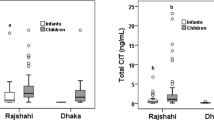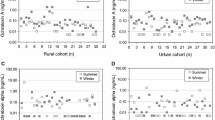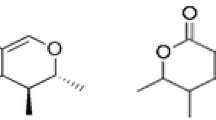Abstract
Ochratoxin A (OTA) and citrinin (CIT) are both nephrotoxic and teratogenic in animals, and the occurrence of these mycotoxins in food may cause adverse health effects in humans. Data on the combined exposure to these food contaminants are still scarce, especially in pregnancy. Therefore, a biomonitoring study was conducted to determine the presence of urinary biomarkers of exposure to OTA and CIT in pregnant women in Bangladesh. In total, 54 spot urine samples were collected from residents of a rural and a suburban area of the Savar region in Dhaka district for analysis of OTA and CIT urinary biomarkers by previously validated HPLC-FD and LC-MS/MS methods. Most urines were positive for OTA and CIT biomarkers, with OTA being detected in 93 % (range 0.01–0.84 ng/mL) and CIT biomarkers in 87 % (range 0.02–6.93 ng/mL) of all samples. The mean levels of OTA were different between the rural (0.06 ± 0.07 ng/mL) and suburban (0.15 ± 0.19 ng/mL) study participants. CIT and its metabolite dihydrocitrinone (HO-CIT) were more than twofold higher in the rural (0.42 ± 1.20 and 0.55 ± 1.04 ng/mL, respectively) than the suburban (CIT 0.15 ± 0.13 ng/mL; HO-CIT 0.23 ± 0.18 ng/mL) participants. When a provisional daily intake for CIT was calculated, it exceeded the preliminary tolerable value set by European Food Safety Authority (0.2 μg/kg/day) in 9 % of the rural participants but in none of the urban participants. Urinary biomarker levels for OTA and CIT did not show significant association with intake of certain types of food consumed by the pregnant women, although total CIT biomarker levels were considerably higher among participants who consumed more rice in a day. Overall, this study indicates a frequent co-exposure to OTA and CIT among pregnant women in Bangladesh, at levels similar to those determined recently in the general population of this country.


Similar content being viewed by others
Abbreviations
- CIT:
-
Citrinin
- HO-CIT:
-
Dihydrocitrinone
- OTA:
-
Ochratoxin A
- OTα:
-
Ochratoxin alpha
References
Ali N, Blaszkewicz M, Manirujjaman M, Perveen R, Nahid AA, Mahmood S, Rahman M, Hossain K, Degen GH (2014) Biomonitoring of ochratoxin A in blood plasma and exposure assessment of adult students in Bangladesh. Mol Nutr Food Res 58:2219–2225
Ali N, Blaszkewicz M, Degen GH (2015a) Occurrence of the mycotoxin citrinin and its metabolite dihydrocitrinone in urines of German adults. Arch Toxicol 89:573–8
Ali N, Blaszkewicz M, Mohanto NC, Rahman M, Alim A, Hossain K, Degen GH (2015b) First results on analysis of citrinin biomarkers in urines from two cohorts in Bangladesh. Mycotoxin Res 31:9–16
Ali N, Blaszkewicz M, Degen GH (2015c) Investigations on biomarkers of citrinin and ochratoxin A exposure in humans. 37th Mycotoxin workshop, June 1–3, 2015. Bratislava, Program and Abstract Book, p 126, # P66
Ali N, Blaszkewicz M, Alim A, Hossain K, Degen GH (2015d). Urinary biomarkers of ochratoxin A and citrinin exposure in two Bangladeshi cohorts: follow-up study on regional and seasonal influences. Arch Toxicol, e-pub Dec 26, 2015; DOI :10.1007/s00204-015-1654-y
Ali N, Blaszkewicz M, Nahid AA, Rahman M, Degen GH (2015e) Deoxynivalenol exposure assessment for pregnant women in Bangladesh. Toxins (Basel) 7:3845–57
Bansal J, Pantazopoulos P, Tam J, Cavlovic P, Kwong K, Turcotte AM, Lau BP, Scott PM (2011) Surveys of rice sold in Canada for aflatoxins, ochratoxin A and fumonisins. Food Addit Contam Part A Chem Anal Control Expo Risk Assess 28:767–74
Biasucci G, Calabrese G, Di Giuseppe R, Carrara G, Colombo F, Mandelli B, Maj M, Bertuzzi T, Pietri A, Rossi F (2010) The presence of ochratoxin A in cord serum and in human milk and its correspondence with maternal dietary habits. Eur J Nutr 50:211–218
Blaszkewicz M, Liesenhoff-Henze K (2012) Creatinine in urine [Biomonitoring Methods, 2010]. The MAK Collection for Occupational Health and Safety, pp. 169–184; Wiley VCH. DOI: 10.1002/3527600418.bi6027urie0012
Blaszkewicz M, Muñoz K, Degen GH (2013) Methods for analysis of citrinin in human blood and urine. Arch Toxicol 87:1087–1094
Castegnaro M, Canadas D, Vrabcheva T, Petkova-Bocharova T, Chernozemsky IN, Pfohl-Leszkowicz A (2006) Balkan endemic nephropathy: role of ochratoxin A through biomarkers. Mol Nutr Food Res 50:519–529
Coronel MB, Marin S, Tarragó M, Cano-Sancho G, Ramos AJ, Sanchis V (2011) Ochratoxin A and its metabolite ochratoxin alpha in urine and assessment of the exposure of inhabitants of Lleida, Spain. Food Chem Toxicol 49:1436–1442
Dawlatana M, Coker RD, Nagler MJ, Wild CP, Hassan MS, Blunden G (2002) The occurrence of mycotoxins in key commodities in Bangladesh: surveillance results from 1993 to 1995. J Nat Toxins 11:379–386
Dawlatana M, Shahida S, Rahim M, Hassan MT (2008) Investigation on the occurrence of ochratoxin A in maize in Bangladesh. Bangladesh J Sci Ind Res 43:495–500
Degen GH (2011) Tools for investigating workplace related risks from mycotoxin exposure. World Mycotoxin J 4:315–327
Degen GH (2015) Are we ready to estimate daily ochratoxin A intake based on urinary concentrations? Environ Int (2015), http://dx.doi.org/10.1016/j.envint.2015.10.010
Duarte SC, Pena A, Lino CM (2011) Human ochratoxin A biomarkers: from exposure to effect. Crit Rev Toxicol 41:187–212
Duarte SC, Alves MR, Pena A, Lino CM (2012) Determinants of ochratoxin A exposure—a one year follow-up study of urine levels. Int J Hyg Environ Health 215:360–367
EC/SCOOP (2002) Assessment of dietary intake of ochratoxin A by the population of EU member states. Report of the Scientific Cooperation (SCOOP), task 3.2.7. Directorate General Health and Consumer Protection, European Commission. Available at http://ec.europa.eu/food/fs/scoop/index_en.html
Ediage EN, Di Mavungu JD, Song S, Sioen I, De Saeger S (2013) Multimycotoxin analysis in urines to assess infant exposure: a case study in Cameroon. Environ Int 57–58:50–59
European Food Safety Authority (EFSA) (2006) Opinion of the Scientific Panel on Contaminants in the food chain on a request from the commission related to ochratoxin A in food. EFSA J 365:1–56
European Food Safety Authority (EFSA), Panel on Contaminants in the Food Chain (2012) Scientific opinion on the risks for public and animal health related to the presence of citrinin in food and feed. EFSA J 10:2605
Ezekiel CN, Warth B, Ogara IM, Abia WA, Ezekiel VC, Atehnkeng J, Sulyok M, Turner PC, Tayo GO, Krska R, Bandyopadhyay R (2014) Mycotoxin exposure in rural residents in northern Nigeria: a pilot study using multi-urinary biomarkers. Environ Int 66:138–45
Föllmann W, Behm C, Degen GH (2014) Toxicity of citrinin and its metabolite dihydrocitrinone and of mixtures of citrinin and ochratoxin A in vitro. Arch Toxicol 88:1097–107
Frisvad JC, Thrane U, Samson RA, Pitt JI (2006) Important mycotoxins and the fungi which produce them. Adv Exp Med Biol 571:3–31
Fromme H, Gareis M, Völkel W, Gottschalk C (2016) Overall internal exposure to mycotoxins and their occurrence in occupational and residential settings—an overview. Int J Hyg Environ Health 219:143–165
Gerding J, Ali N, Schwartzbord J, Cramer B, Brown DL, Degen GH, Humpf HU (2015) A comparative study of the human urinary mycotoxin excretion patterns in Bangladesh, Germany and Haiti using a rapid and sensitive LC-MS/MS approach. Mycotoxin Res 31:127–136
Heyndrickx E, Sioen I, Huybrechts B, Callebaut A, De Henauw S, De Saeger S (2015) Human biomonitoring of multiple mycotoxins in the Belgian population: results of the BIOMYCO study. Environ Int 84:82–89
Hornung RW, Reed LD (1990) Estimation of average concentration in the presence of nondetectable values. Appl Occup Environ Hyg 5:46–51
Huybrechts B, Debongnie P, Uhlig S, Callebaut A (2015) Fast and sensitive LC-MS/MS method measuring human mycotoxin exposure using biomarkers in urine. Arch Toxicol 89:1993–2005
IARC - International Agency for Research on Cancer (1986) Citrinin: some naturally occurring and synthetic food components, furocoumarins and ultraviolet radiation. IARC Monogr Eval Carcinog Risk Chem Hum 40:67
IARC - International Agency for Research on Cancer (1993) Some naturally occurring substances: heterocyclic aromatic amines and mycotoxins. IARC Monogr Eval Carcinog Risk Chem Hum 56:397–444
Jeswal P, Kumar D (2015) Mycobiota and natural incidence of aflatoxins, ochratoxin A, and citrinin in Indian spices confirmed by LC-MS/MS. Int J Microbiol 2015:242486
Jonsyn FE, Maxwell SM, Hendrickse RG (1995) Human fetal exposure to ochratoxin A and aflatoxins. Ann Trop Paediatr 15:3–9
Klapec T, Sarkanj B, Banjari I, Strelec I (2012) Urinary ochratoxin A and ochratoxin alpha in pregnant women. Food Chem Toxicol 50:4487–92
Lai X, Liu R, Ruan C, Zhang H, Liu C (2014) Occurrence of aflatoxins and ochratoxin A in rice samples from six provinces in China. Food Control 50:401–404
Majeeda S, Iqbala M, Asib MR, Iqbalc SZ (2013) Aflatoxins and ochratoxin A contamination in rice, corn and corn products from Punjab, Pakistan. J Cereal Sci 58:446–450
Malir F, Ostry V, Pfohl-Leszkowicz A, Novotna E (2013a) Ochratoxin A developmental and reproductive toxicity—an overview. Birth Defects Res B Dev Reprod Toxicol 98:493–502
Malir F, Ostry V, Dofkova M, Roubal T, Dvorak V, Dohnal V (2013b) Ochratoxin A levels in blood serum of Czech women in the first trimester of pregnancy and its correspondence with dietary intake of the mycotoxin contaminant. Biomarkers 18:673–678
Mally A (2012) Ochratoxin A and mitotic disruption: mode of action analysis of renal tumor formation by ochratoxin A. Toxicol Sci 127:315–330
Märtlbauer E, Usleber E, Dietrich R, Schneider E (2009) Ochratoxin A in human blood serum—retrospective long-term data. Mycotoxin Res 25:175–186
Mayura K, Parker R, Berndt WO, Phillips TD (1984) Effect of simultaneous prenatal exposure to ochratoxin A and citrinin in the rat. J Toxicol Environ Health 13:553–561
Mikhail MS, Anyaegbunam A (1999) Lower urinary tract dysfunction in pregnancy: a review. Obstet Gynecol Surv 50:675–683
Molinie A, Faucet V, Castegnaro M, Pfohl-Leszkowicz A (2005) Analysis of some breakfast cereals on the French market for their contents of ochratoxin A, citrinin and fumonisin B1: development of a method for simultaneous extraction of ochratoxin A and citrinin. Food Chem 92:391–400
Muñoz K, Blaszkewicz M, Degen GH (2010a) Simultaneous analysis of ochratoxin A and its major metabolite ochratoxin alpha in plasma and urine for an advanced biomonitoring of the mycotoxin. J Chromatogr B 878:2623–2629
Muñoz K, Campos V, Blaszkewicz M, Vega M, Alvarez A, Neira J, Degen GH (2010b) Exposure of neonates to ochratoxin A: first biomonitoring results in human milk (colostrum) from Chile. Mycotoxin Res 26:59–67
Muñoz K, Blaszkewicz M, Campos V, Vega M, Degen GH (2014) Exposure of infants to ochratoxin A with breast milk. Arch Toxicol 88:837–846
Nguyen M, Tozlovanu M, Tran T, Pfohl-Leszkowicz A (2007) Occurrence of aflatoxin B1, citrinin and ochratoxin A in rice in five provinces of the central region of Vietnam. Food Chem 105:42–47
Ostry V, Malir M, Ruprich J (2013) Producers and important dietary sources of ochratoxin A and citrinin. Toxins 5:1574–1586
Peraica M, Domijan A-M, Miletic-Medved M, Fuchs R (2008) The involvement of mycotoxins in the devlopment of endemic nephropathy. Wien Klin Wochenschr 120:402–407
Pfohl-Leszkowicz A (2009) Ochratoxin A and aristolochic acid in the nephropathies and associated urothelial tract tumours development. Arh Hig Rada Toksikol 60:465–483
Pfohl-Leszkowicz A, Manderville RA (2007) Ochratoxin A: an overview on toxicity and carcinogenicity in animals and humans. Mol Nutr Food Res 51:61–99
Reddy RV, Hayes AW, Berndt WO (1982) Disposition and metabolim of [14C]citrinin in pregnant rats. Toxicology 25:161–74
Reddy BN, Nusrath M, Kumari CK, Nahdi S (1983) Mycotoxin contamination in some food commodities from tribal areas of Medak District, Andhra Pradesh. Indian Phytopathol 36:683–686
Saxena J, Mehrotra BS (1989) Screening of spices commonly marketed in India for natural occurrence of mycotoxins. J Food Compos Anal 2:286–292
Sherif SO, Salama EE, Abdel-Wahhab MA (2009) Mycotoxins and child health: the need for health risk assessment. Int J Hyg Environ Health 212:347–68
Singh ND, Sharma AK, Patil RD, Leishangthem GD, Kumar M (2014) Effect of feeding graded doses of citrinin on clinical and teratology in female Wistar rats. Indian J Exp Appl Biol 52:159–167
Solfrizzo M, Gambacorta L, Visconti A (2014) Assessment of multi-mycotoxin exposure in Southern Italy by urinary multi-biomarker determination. Toxins 6:523–538
Studer-Rohr I, Schlatter J, Dietrich DR (2000) Kinetic parameters and intraindividual fluctuations of ochratoxin A plasma levels in humans. Arch Toxicol 74:499–510
Turner PC, Flannery B, Isitt C, Ali M, Pestka J (2012) The role of biomarkers in evaluating human health concerns from fungal contaminants in food. Nutr Res Rev 25:162–179
Wallin S, Gambacorta L, Kotova N, Warensjö Lemming E, Nälsén C, Solfrizzo M, Olsen M (2015) Biomonitoring of concurrent mycotoxin exposure among adults in Sweden through urinary multi-biomarker analysis. Food Chem Toxicol 83:133–9
Woo CSJ, Partanen H, Myllynen P, Vähäkangas K, El NH (2012) Fate of the teratogenic and carcinogenic ochratoxin A in human perfused placenta. Toxicol Lett 208:92–99
Yogendrarajah P, Jacxsens L, De Saeger S (2014) Co-occurrence of multiple mycotoxins in dry chilli (Capsicum annum L.) samples from the markets of Sri Lanka and Belgium. Food Control 46:26–34
Zimmerli B, Dick R (1995) Determination of ochratoxin A at the ppt level in human blood, serum, milk and some foodstuffs by high-performance liquid chromatography with enhanced fluorescence detection and immunoaffinity column cleanup: methodology and Swiss data. J Chromatogr B Biomed Appl 666:85–99
Acknowledgments
The authors wish to thank the village health workers who helped in urine sample collection and all volunteers for participating in this study, and we are much obliged to Iris Glaeser for excellent technical assistance in LC-MS/MS analysis. This work was supported by a DAAD scholarship to Nurshad Ali.
Author information
Authors and Affiliations
Corresponding author
Ethics declarations
All participants were apparently healthy according to external clinical examination by professional nurses, and they gave informed consent prior to study participation. This study was approved by the Institute of Biological Sciences of Rajshahi University, Rajshahi-6205, Bangladesh, and by the Institutional Internal Review Board of IfADo.
Conflict of interest
The authors have no conflict of interest to declare.
Rights and permissions
About this article
Cite this article
Ali, N., Blaszkewicz, M., Manirujjaman, M. et al. Biomonitoring of concurrent exposure to ochratoxin A and citrinin in pregnant women in Bangladesh. Mycotoxin Res 32, 163–172 (2016). https://doi.org/10.1007/s12550-016-0251-0
Received:
Revised:
Accepted:
Published:
Issue Date:
DOI: https://doi.org/10.1007/s12550-016-0251-0




